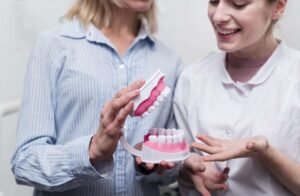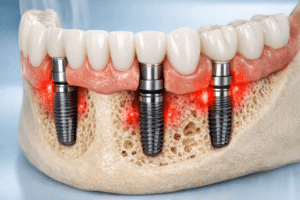When a tooth is lost, a physiological resorption process starts. The alveolar crest of the jaw begins to decrease just a few days after tooth extraction. Three main physiological mechanisms are accountable for remodeling the alveolar bone: adaptation to functional loading, removal of excessive load and bone minimization, and bone resorption without removing the implant. Understanding these processes is crucial for those seeking solutions on how to regrow jaw bone naturally. New advancements in regenerative dentistry also explore how to regenerate jaw bone naturally, aiming to restore bone structure and function without invasive surgery.
How Long Does It Take for Bone Loss After Tooth Extraction?
How to Regrow Jaw Bone Naturally After Tooth Loss
The process of bone remodeling after tooth extraction is largely controlled by molecular signaling pathways that activate osteoclasts. These pathways are also being studied in efforts to regrow human teeth, as researchers aim to understand how to regenerate tooth and bone structures simultaneously.Understanding this process is key for developing future therapies aimed at helping the body regrow adult teeth naturally. Learn more about emerging techniques in regrow adult teeth . However, this process is slow, and conditions like periodontal disease can accelerate bone resorption. When a tooth is extracted, the inflammatory response becomes more severe than the normal physiological reaction, leading to significant bone ridge deformity. This can severely impact the ability to fit dentures or implants. Techniques such as massaging gums to regrow may help support gum and bone health during the healing process.. For patients wondering how to regrow jaw bone naturally, regenerative techniques like stem cell therapy, bone grafting, and the use of growth factors are under investigation. These approaches aim to reverse resorption and restore the structure needed for prosthetic attachment.
Does Jaw Bone Regenerate and How to Grow Back Jaw Bone
Studies show that most alveolar bone loss occurs within the first year after extraction. Vertical loss can reach 11–22%, while horizontal resorption may exceed 50% of the original bone width. This raises concern for patients asking, does jaw bone regenerate or how to grow back jaw bone. In many cases, standard implant placement becomes impossible without prior augmentation. Promising research into jaw bone regrowth focuses on composite grafts and advanced substitutes designed to fill and restore the deficient ridge. Understanding how to regrow jaw bone is essential for clinicians aiming to offer long-term, stable solutions for patients requiring dental reconstruction.
How Can I Improve My Bone Growth After Tooth Extraction and how to regrow jaw bone naturally?
Jaw Bone Loss: Causes, Effects, and Regrowth Options
The jaw bones support the teeth, facial muscles, and temporomandibular joint (TMJ), which is vital for speech and chewing.
When teeth are lost, the surrounding bone begins to resorb due to lack of stimulation.
The most severe resorption often occurs in cases of periodontal disease.
This bone loss distorts the alveolar ridge, increasing the risk of implant failure.
The maximum vertical bone loss usually happens within the first three months post-extraction.
Patients with 90 percent bone loss in teeth may be at risk of facial structural changes and denture instability.
Many now ask how to regrow jaw bone naturally as an alternative to traditional implants or dentures.
Techniques such as stem cell therapy, growth factors, and scaffold-supported regeneration offer promising paths to restore bone naturally.
Managing and Preventing Bone Loss in Teeth
Bone is naturally remodeled throughout life, but after tooth loss, this process accelerates without proper stimulation. Techniques like massaging gums to regrow may help encourage healthier tissue and support bone regeneration.
Bone grafting is a common technique, but outcomes vary depending on the material used.
Identifying early symptoms of bone loss in teeth, such as gum recession, loose teeth, or jaw pain, is essential.
For many, understanding how to slow down bone loss in teeth through oral hygiene and professional care is crucial.
The best treatment for bone loss in teeth often combines lifestyle changes, regenerative therapies, and personalized care plans.
Additionally, strategies on how to increase jaw bone density—including diet, supplements, and bone-stimulating techniques—are gaining attention.
Encouragingly, in some cases, bone can grow back around teeth, especially when detected and treated early.
How Do You Stimulate Bone Growth and how to regrow jaw bone naturally?
Jaw Bone Loss: Causes, Effects, and Regrowth Options
The jaw bones support the teeth, facial muscles, and temporomandibular joint (TMJ), which is vital for speech and chewing.
When teeth are lost, the surrounding bone begins to resorb due to lack of stimulation.
The most severe resorption often occurs in cases of periodontal disease.
This bone loss distorts the alveolar ridge, increasing the risk of implant failure.
The maximum vertical bone loss usually happens within the first three months post-extraction.
Patients with 90 percent bone loss in teeth may be at risk of facial structural changes and denture instability.
Many now ask how to regrow jaw bone naturally as an alternative to traditional implants or dentures.
Techniques such as stem cell therapy, growth factors, and scaffold-supported regeneration offer promising paths to restore bone naturally.
Managing and Preventing Bone Loss in Teeth
Bone is naturally remodeled throughout life, but after tooth loss, this process accelerates without proper stimulation.
Bone grafting is a common technique, but outcomes vary depending on the material used.
Identifying early symptoms of bone loss in teeth, such as gum recession, loose teeth, or jaw pain, is essential.
For many, understanding how to slow down bone loss in teeth through oral hygiene and professional care is crucial.
The best treatment for bone loss in teeth often combines lifestyle changes, regenerative therapies, and personalized care plans.
Additionally, strategies on how to increase jaw bone density—including diet, supplements, and bone-stimulating techniques—are gaining attention.
Encouragingly, in some cases, bone can grow back around teeth, especially when detected and treated early.



